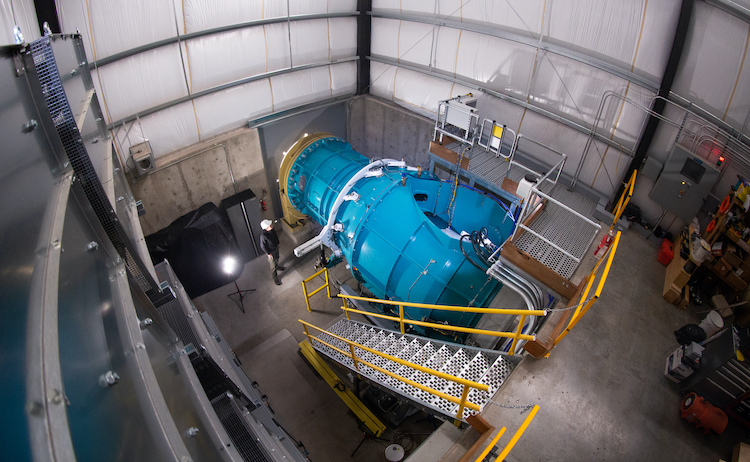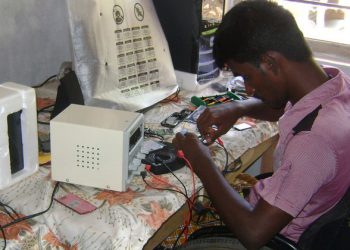
By Gia Schneider, CEO and co-founder at Natel Energy
Hydropower sits at the nexus of energy and water, enabling hydropower projects to be unique catalysts for positive change. If designed with both energy and water in mind, hydropower projects can increase reliable renewable generation and deliver positive co-benefits for river ecosystems and water users. Conventional approaches to hydropower did not always adequately consider the ecosystem impacts of large structures — but major shifts in the hydropower industry are underway.
What is keeping the U.S. from fully embracing a new generation of hydropower? Explained below are 5 major myths about hydropower.
Myth 1: Hydropower plants have to be massive in order to be efficient.
Many people think that only the largest projects on a massive grid are efficient enough to be worth developing.
The truth is that with modern technology solutions, it is possible to develop and operate distributed hydropower projects, networked together into virtual power plants at scale and cost-effectively. By leveraging advances in distributed energy resource management, microgrids, and batteries, virtual power plants offer increased power generation without the environmental impact. Low head, fish-safe and in-stream turbine technology has a lower environmental impact, and enables a new approach to hydropower design that is far more distributed and modular than in the past.

A recent NREL cost analysis of distributed, interconnected hydropower projects linked to create a virtual power plant demonstrated that the revenue reduction from the operational changes needed to achieve environmental objectives was small, at less than 4%.
Myth 2: Hydropower and river sustainability objectives are always at odds.
Large dams built decades ago, such as the Hoover Dam, are often what comes to mind when thinking about river sustainability and hydropower. These traditional dams don’t emit carbon dioxide, however they do pose issues for river connectivity for both aquatic species (fish) as well as sediment. Such dams disrupt the ability of fish and other aquatic species to move upstream and downstream easily; and they also trap sediment, often starving downstream river reaches of nutrients and sediment. This often leads to downstream degradation of the river channel and stream-bank erosion.
However, in an unprecedented move, industry groups and environmentalists came together in what’s been called the Uncommon Dialogue to collaborate on a set of specific policy measures that could help generate more reliable, renewable electricity from some of the nation’s 90,000 dams already in place, while also agreeing to retrofitting or remove dams that are unsafe, ecologically damaging or simply beyond their useful life. This would help both increase our nation’s supply of reliable renewable energy, supporting the transition to a zero carbon grid, while also improving the safety of our water infrastructure and restoring river connectivity.
The Uncommon Dialogue resulted in a Joint Statement which was signed by the National Hydropower Association as well as environmental groups including American Rivers, the World Wildlife Fund and the Union of Concerned Scientists, showing a joint effort to align hydropower with river sustainability goals long term.
Related: The Uncommon Dialogue will be discussed at the upcoming HydroVision International event, set for September 21-23, 2021 in Spokane, Washington. Learn about the session here.
Myth 3: Hydropower is a tapped out resource – everything has been developed.
Modern distributed hydropower is the future of hydropower infrastructure as it is expensive and inefficient to build new dams. At present, the majority of existing dams in the U.S.—more than 90 percent, or 80,000 dams—don’t produce electricity. These dams can be retrofitted to produce new, reliable renewable power and improve environmental impacts. Some of these dams are candidates for removal, paired with new approaches to add hydropower as part of river restoration post-removal. Finally, additional distributed projects with low-head, fish-safe turbines can be developed, again incorporating proven civil and environmental engineering designs used extensively in river restoration. In total, these potential resources in the U.S. could increase hydropower generation by up to 50%.
Myth 4: Hydropower is not reliable.
Hydropower offers dispatchable power, a predictable and flexible generation source that can serve as the backbone for a mix of other power sources. Since rivers flow consistently, including at night, turbines continue to spin and produce power, unlike wind or solar power, which have more intermittent generation profiles. Rather than being at odds with wind and solar, hydropower is actually quite complementary, with its ability to easily flex up or down and provide support to the grid depending on what is happening with wind and solar at any given point. This flexibility enables hydropower to help integrate more wind and solar, and support the most cost effective utilization of battery storage to support shifting the grid towards zero carbon in the future.
Grid reliability can be impacted by hydropower in very effective ways. Texas just this past winter faced extreme grid challenges that could have been prevented with a more diverse power supply structure. In addition, as solar and wind continue their growth, large-scale storage will be needed. Surplus energy will need to be stored from periods of intense wind or sun, for use when wind slows or night falls. Hydropower is currently the most robust energy storage and pumped-storage currently accounts for 95% of all utility-scale energy storage in the United States.
Myth 5: Hydropower is not part of the future of clean energy.
Hydropower is not a single solution that will magically make the transition to a reliable, zero carbon grid happen easily. However, hydropower has a substantial role to play in a clean and ethical energy transition plan for several reasons.
Energy experts have said that adding more hydropower could provide a useful tool in the fight against climate change. Over the past decade, wind turbines and solar panels have come down their cost curves to the point where they are mass deployable solutions, but they are intermittent and don’t run all the time. Hydropower can offer a backstop, providing flexible, reliable power and complementing battery storage.
Conclusion
Hydropower is the generation of electricity from flowing water – rivers, streams, ocean tides and currents. It is a clean, domestic, renewable energy source that is flexible and reliable, and can serve up to one-third of grid reserve requirements – critical support to aid the integration of wind and solar as we transition to a zero carbon grid.
About the Author

Gia Schneider is co-founder and Chief Executive Officer of Natel Energy. Gia has more than 20 years of experience in the energy industry in asset management, asset value, and carbon emissions trading. She has led and directed diverse teams from utility practice to establishing the energy trading desk at Credit Suisse. Most recently, she worked at Constellation Energy on optimizing generation asset value. Before that, she provided strategic solutions to major energy companies with Accenture around asset management. Schneider has a Bachelor of Science in Chemical Engineering from MIT. She founded Natel Energy in 2009 with her brother, Abe Schneider, motivated by the theme of climate change driving changes in water patterns and focused on the opportunity to innovate hydropower solutions that catalyze sustainable river outcomes while producing reliable renewable energy. Gia is passionate about finding economically viable solutions to mitigate climate change, foster sustainable development and produce inexpensive renewable energy. In her spare time, she can be found surfing, kiting, and cooking with family and friends.





